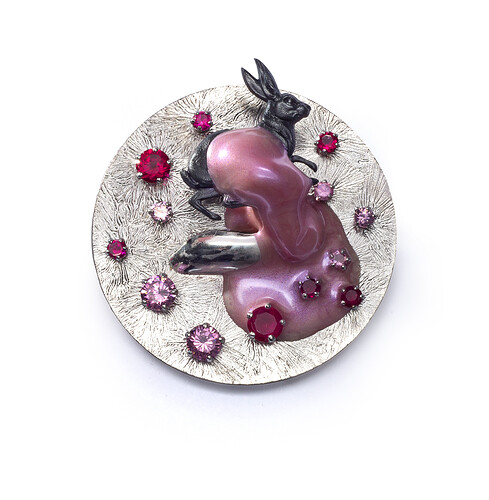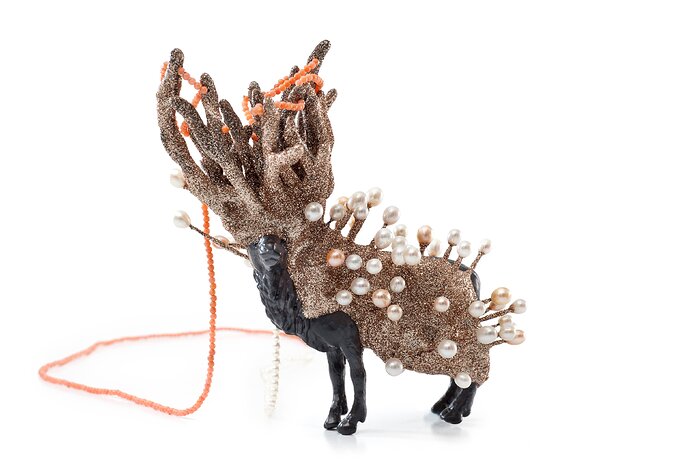Materials: sterling silver, brass, Teflon plating, rhodium plating, zircon gem ,epoxy resin, epoxy chips, Acrylin paint
Dimensions: 5*4.5*2.5
Brooch, 2012
Photo credit: Shirly Bar Amotz
Shirly Bar Amotz
Kibbutz Maabarot, Israel
Shirly Bar-Amotz
Born in Israel, in 1974
My medium is jewelry and the fine art. I live in Kibbutz Ma'abarot, where I work as an artist and teach in the kibbutz studio, which I founded. As well, I lecture in the Dept. of Jewelry at the Bezalal Academy of Art and Design, Jerusalem.
My work is a combination of various disciplines in which I use a variety of materials. Craft work and the involvement of materials play a significant part in the process of the work's conceptual development.
I create sculptures, paintings, and jewelry from different materials, such as glass, ceramics, porcelain, plastic, rubber, and pure gold and silver. The material itself is an important element in the building process of my works' narratives.
Cultural strata, the political context, and Israel's reality as seen through my eyes, are all reflected in my works through sculpture, painting, and jewelry.
In the Series "Happy Days" (2012), Color is the final step at my work. It has a very important and dominant part in the jewelry, that's also where I have my greatest satisfaction. The animal Images on the jewels are caged, unable to move within the mountains of the colorful materials that cover them. Therefore, despite the cheerful colors, they are at controversial situation, where there appear to be great joy, but there's also a lot of sadness.
The exhibition explores metal works whose primary theme is color embraced as their primary visual focus, whether that be using colored materials, exploring creating colored surfaces, or encasing the object in color.
As the world's largest jewelry related internet site, Ganoksin strives to develop exhibitions showcasing work from around the world. This exhibition was open to all metalsmiths, professional and amateur, advanced and beginner.
In total 303 artists contributed 814 show pieces for the permanent online exhibition.
The exhibition was curated by Beth Wicker, President of the North Carolina Society of Goldsmiths in the United States, and Adjunct Instructor at Northeastern Technical College in South Carolina. Director of the exhibition is Hanuman Aspler, founder of The Ganoksin Project, the world's largest internet jewelry site.
Hue is one of the primary properties of color, it refers to the place the color occupies on the visual spectrum. Humans have used hues throughout time, to create cave paintings, to decorate themselves, their clothing and their housing.
Different hues have taken on different meanings throughout time. Gold traditionally has been a color of purity - the metal gold is relatively unchangeable, and the hue of gold has come to stand for gods and goddesses, for royalty, for durability and for purity. Red has often meant love, or passion. Hues often reflect the meaning of the seasons, with pastels referring to spring and the burst of new life after the pale hues of winter. Summer is reflected in vibrant, deep hues, followed by the browning of hues in the fall as plants go to seed and die, and the land turns fallow.
The worth of a hue has often been tied to what is necessary to make the pigment that creates the hue, and the expensive involved in the process. Often created from crushed stones that had to be mined and carried by caravan over thousands of miles, or from fermented roots of plants only grown in certain areas, or the carapaces of rare insects - the creation of hue in a way that could be used by man was an involved and generally expensive process.
In today's world metalsmiths have access to perhaps the widest range of materials and hues in the history of man - and in some of the most affordable ways ever.
This exhibition celebrates hue - color - as an integral, inherent element of the work. We talk of the "richness" of color, and examples of this abound here. One expects hues from the colors of gemstones used in metalsmithing, but we also have hues from some less expected places. Glass enamels are an ancient way of adding color, as are a variety of patinas. Today's artists also use synthetic man-made materials to add color in ways that didn't exist a century ago.
We invite you to enjoy this celebration of hue, and the ways hues and their use have changed over time.
http://www.ganoksin.com/exhibition/var/albums/Changing-Hues/7.jpg

